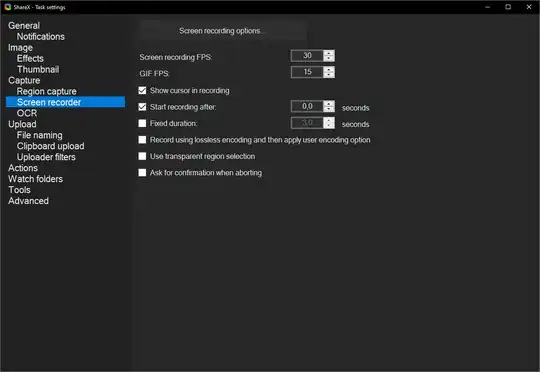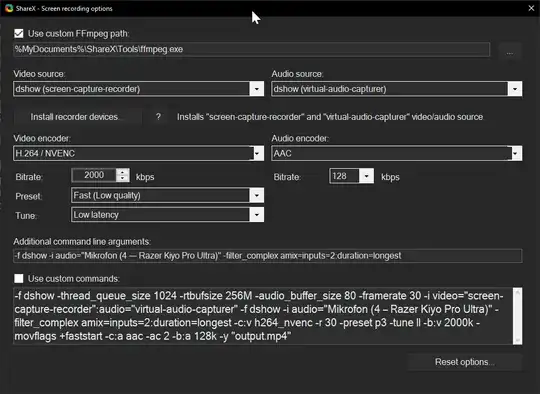I saw that here are asked questions related to encoding and ShareX, so I decided to ask in this portal.
Basically I recorded video using ShareX 16.1. ffmpeg version:
ffmpeg version n7.0-14-g2d3ee7c069-20240423 Copyright (c) 2000-2024 the FFmpeg developers
built with gcc 13.2.0 (crosstool-NG 1.26.0.65_ecc5e41)
configuration: --prefix=/ffbuild/prefix --pkg-config-flags=--static --pkg-config=pkg-config --cross-prefix=x86_64-w64-mingw32- --arch=x86_64 --target-os=mingw32 --enable-gpl --enable-version3 --disable-debug --disable-w32threads --enable-pthreads --enable-iconv --enable-libxml2 --enable-zlib --enable-libfreetype --enable-libfribidi --enable-gmp --enable-fontconfig --enable-libharfbuzz --enable-libvorbis --enable-opencl --disable-libpulse --enable-libvmaf --disable-libxcb --disable-xlib --enable-amf --enable-libaom --enable-libaribb24 --enable-avisynth --enable-chromaprint --enable-libdav1d --enable-libdavs2 --enable-libdvdread --enable-libdvdnav --disable-libfdk-aac --enable-ffnvcodec --enable-cuda-llvm --enable-frei0r --enable-libgme --enable-libkvazaar --enable-libaribcaption --enable-libass --enable-libbluray --enable-libjxl --enable-libmp3lame --enable-libopus --enable-librist --enable-libssh --enable-libtheora --enable-libvpx --enable-libwebp --enable-lv2 --enable-libvpl --enable-openal --enable-libopencore-amrnb --enable-libopencore-amrwb --enable-libopenh264 --enable-libopenjpeg --enable-libopenmpt --enable-librav1e --enable-librubberband --enable-schannel --enable-sdl2 --enable-libsoxr --enable-libsrt --enable-libsvtav1 --enable-libtwolame --enable-libuavs3d --disable-libdrm --enable-vaapi --enable-libvidstab --enable-vulkan --enable-libshaderc --enable-libplacebo --enable-libx264 --enable-libx265 --enable-libxavs2 --enable-libxvid --enable-libzimg --enable-libzvbi --disable-doc --disable-ffplay --disable-ffprobe --extra-cflags=-DLIBTWOLAME_STATIC --extra-cxxflags= --extra-libs=-lgomp --extra-ldflags=-pthread --extra-ldexeflags= --cc=x86_64-w64-mingw32-gcc --cxx=x86_64-w64-mingw32-g++ --ar=x86_64-w64-mingw32-gcc-ar --ranlib=x86_64-w64-mingw32-gcc-ranlib --nm=x86_64-w64-mingw32-gcc-nm --extra-version=20240423
libavutil 59. 8.100 / 59. 8.100
libavcodec 61. 3.100 / 61. 3.100
libavformat 61. 1.100 / 61. 1.100
libavdevice 61. 1.100 / 61. 1.100
libavfilter 10. 1.100 / 10. 1.100
libswscale 8. 1.100 / 8. 1.100
libswresample 5. 1.100 / 5. 1.100
libpostproc 58. 1.100 / 58. 1.100
Universal media converter
usage: ffmpeg [options] [[infile options] -i infile]... {[outfile options] outfile}...
Settings inside ShareX are:
On last screen you can see, that I copied additional command line arguments for recording with microphone.
I recorded 2h video and was happy to watch the material the next day, but when I opened VLC or Media Player Classic (latest version) and wanted to jump to 1 h 5 min of video it took about ~10 minutes to get there...
Not sure whether this issue is related with NVENC (I have 3770k and GTX1070ti, so I decided to use GPU, this CPU is getting overwhelmed with various programs and stuff) or if it's just ShareX behaviour.
It seems very strange that ShareX recordings do not seek quickly. Basically If I go to 01:05:00 it takes about ~10 minutes. And then I want to go to 01:30:00 and it will take again enourmous amount of time.
Just as if this video was recorded using 'monolythic' block and not in 'chunks' so jumping takes enourmous amount of time.
What do I need to add to make seeking work fast? I am guessing maybe I should add something inside Additional command line arguments, just like for normal YouTube movie or any movie from any service e.g. Netflix? Or, unlikely, maybe I can't do this?
I am also open to other suggestions with encoding and various parameters, but the main culprit is this jumping issue.

